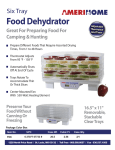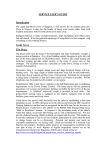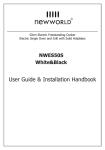Download USER MANUAL FOOD DEHYDRATOR
Transcript
MK Food Dehydrator 14210 IB A:Layout 1 31/3/10 11:48 Page 1 USER MANUAL FOOD DEHYDRATOR Model: 14210 Helpline No: 015394 88100 The Lakeland Guarantee.... is probably the simplest guarantee in the world! If you are not satisfied at any time, you receive your money back! This is our promise. Lakeland Alexandra Buildings, Windermere, Cumbria LA23 1BQ Tel: 015394 88100 Web: www.lakeland.co.uk MK Food Dehydrator 14210 IB A:Layout 1 31/3/10 11:48 Page 3 INTRODUCTION Thank you for choosing this food dehydrator from My Kitchen, a hard-working range of everyday cooks’ essentials by Lakeland. The food dehydrator preserves fresh fruit, vegetables and herbs by circulating hot air around them to remove their moisture content. Natural flavours and sweetness are concentrated and, once dried, the food has a much longer shelf life than fresh produce. Please take a few moments to read these instructions before using your food dehydrator for the first time, and keep them in a safe place for future reference. FEATURES 1. Top lid 2. Adjustable food trays 3. Heated base 4. On/off switch Operating voltage: 220-240V~ 50Hz Power: 250W IMPORTANT SAFEGUARDS When using this food dehydrator, please follow these basic safety precautions. 1. Please read all instructions before using. 2. Make sure your electricity supply matches the voltage shown on the appliance. 3. This food dehydrator is for household use only. It is not suitable for commercial use, or for use outdoors. The food dehydrator must only be used for its intended purpose of drying fresh fruit, vegetables and herbs. 4. Place the food dehydrator on a dry, level and HEATPROOF surface. Do not let the power cord touch any hot surfaces or hang over the edge of your worktop, where a child could grab it. 5. Do not place the food dehydrator on or near a hot gas or electric burner, or in or near a heated oven. 6. The food dehydrator will get hot during use. Take care not to touch the hot surfaces, and let food cool before handling it. 7. Keep the food dehydrator well away from curtains, wall cabinets, clothing, tea towels etc. Do not place anything on top of the appliance during use. 8. Always switch off and unplug the food dehydrator before adding or removing the trays, when not in use and before cleaning. Grasp the plug, not the cord. Let the food dehydrator cool down completely before cleaning. 9. To avoid electric shock, do not let the food dehydrator, power cord or plug get wet. Never immerse the base in water or any liquid when cleaning. Do not touch with wet hands. 10. Using accessories that are not recommended by the manufacturer may cause fire, electric shock or injury, and should be avoided. 11. The food dehydrator is not intended for use by children or infirm people unless they have been adequately supervised by a responsible person to ensure they can use it safely. Children should be supervised to ensure they do not play with the food dehydrator. MK Food Dehydrator 14210 IB A:Layout 1 12. 31/3/10 11:48 Page 5 Do not use the food dehydrator if the power cord or plug show any signs of damage, or if the appliance is dropped, damaged or working incorrectly. Call the helpline on 015394 88100 to arrange a repair by an authorised repairer, or a replacement. Never try to repair the food dehydrator yourself as this may cause electric shock. BEFORE USING FOR THE FIRST TIME Carefully unpack the food dehydrator and remove any packaging. Wash the lid and food trays in hot, soapy water, or in the dishwasher. Rinse and dry. Wipe the base with a slightly damp cloth, then dry. It must never be immersed in water or any liquid. TIP: to check the trays are the right way up, look at them sideways on. The top of the tray is narrower than the bottom. 4. The height of each tray can be adjusted to suit thick food up to 2.5cm e.g. broccoli florets, or thin food up to 1.25cm e.g. banana slices. The trays can be stacked in any combination and each tray has smooth and ribbed stacking tabs on the side. For THICK food, stack the trays as shown below, with the smooth tab of the upper tray sitting on top of the ribbed tab of the lower tray. AN INTRODUCTION TO FOOD DEHYDRATING Dehydrating is an age-old method of preserving fresh food. Today, this food dehydrator offers a simple and effective way to dry a wide variety of fruit, vegetables and herbs. It consists of a heated base and 5 stacking food trays which can be adjusted to hold thin or thick food. The base heats up to 85°C whilst a fan circulates hot air around the food to remove its moisture content. For THIN food, rotate the upper tray so that its smooth tab sits next to the ribbed tab The drying process concentrates natural flavour, making for tasty ingredients such as dried mushrooms, tomatoes and herbs which will enhance your soups, stews, casseroles and sauces. Dried fruits make an enjoyable, healthy snack and can also be added to home baking. of the lower tray, as shown below. Drying times vary greatly according to the kind of food selected, the thickness and size of the pieces, and even the temperature of your kitchen. You may find it helpful to keep a record of how long different types of fruit and veg take to dry; you will soon get a feel for how long they take and how best to prepare them. See FOOD DRYING GUIDE. USING YOUR FOOD DEHYDRATOR 1. Firstly, place the food dehydrator onto a heatproof surface, well away from curtains, tea towels etc, with proper ventilation space around it. It will get very hot during use and your worktop or table should be protected from the heat generated by the appliance. 2. 3. Prepare the food – see FOOD DRYING GUIDE – and place it on the trays. Take care not to overload the trays or to overlap the food; the hot air should be able to circulate freely. Leave the central hole uncovered. Making sure the base is switched off and unplugged, stack the trays onto it. We recommend stacking all 5 trays, even if some of them are empty. Trays containing food should be placed at the top of the stack. 5. Place the lid on the top tray. CAUTION; the food dehydrator should never be used without the lid. Plug in the food dehydrator and press the on/off switch on the base. The switch will light up red and you will hear the fan working. 6. When the food is dry, press the on/off switch and unplug the food dehydrator. Let it cool completely before lifting off the trays, removing the food and cleaning. See CARE AND CLEANING. Take care when handling the food; it may be hot. 7. Once the food has cooled completely, store it in airtight containers, labelling and dating the contents. Store in a cool, dry, dark place and check monthly for spoilage. MK Food Dehydrator 14210 IB A:Layout 1 31/3/10 11:48 Page 7 FOOD DRYING GUIDE There are no hard-and-fast rules when it comes to food dehydrating. This guide offers a helpful starting point. Over time you will develop a feel for how long different fruit and vegetables take to dry. The best way is to experiment with different ingredients and to keep a record of what works for you. VEGETABLES We also recommend pre-treating certain types of vegetable before drying: green beans, broccoli, cauliflower, asparagus and potatoes. Blanching the prepared vegetables in a pan of boiling water for 3 to 5 minutes will help to keep their natural colour. Strain and pat dry with kitchen paper before drying. 1. For the best flavour and colour, begin with fresh, fully ripe fruit, veg or herbs. Rinse thoroughly and pat dry with kitchen paper. Discard any damaged, bruised or mouldy pieces. Prepared vegetables can also be dipped in lemon juice for 2 minutes to add a hint of lemon flavour, if desired. This is especially recommended for green beans and asparagus. 2. Prepare the produce as below. Food will dry more evenly if the pieces are sliced to about the same thickness. Thick pieces dry more slowly than thin slices. Fruits should be sliced across the core. A food processor is ideal for fast, even slicing. With so many factors affecting drying times – the type of food, the thickness or size of the pieces, the room temperature – it is impossible to give exact timings. Check the food regularly, letting it cool before handling it to check for doneness. TIP: it is better for food to be slightly over-dry than under-dry as moist food is more likely to spoil during storage. FRUIT To help preserve the natural sweetness, flavour and colour of fruit, we recommend pretreating it before drying. Soak the fruit for around 2 minutes in 480ml water, to which 60ml fruit juice has been added. Where possible, the juice should match the fruit to be dried e.g. apple juice for apples. This method of pre-treating will give the best results. FRUIT Apples Apricots Bananas PREPARATION Peel and core. Cut into rings Halve or slice. Remove pit. Peel and cut into 3mm slices. VEGETABLE Asparagus Beans Broccoli Cabbage Carrots Cauliflower Chives DRYNESS TEST APPROX. DRYING TIME Garlic Pliable 5-6 hours Mushrooms PREPARATION Blanch. Cut into 2cm pieces. Cut and blanch. until translucent Trim and cut. Steam until tender Trim and cut leaves into 5mm strips Steam until tender. Shred or slice. Trim and cut. Blanch. until tender Chop to desired size. Peel clove and slice thinly. Slice, chop or leave whole DRYNESS TEST APPROX. DRYING TIME Brittle 6-14 hours 8-26 hours Brittle Brittle 6-20 hours Leathery 6-14 hours Leathery 6-16 hours Leathery 6-16 hours Brittle 6-10 hours Brittle 6-16 hours Leathery 6-14 hours 12-38 hours Pliable 8-14 hours Onions Crisp 8-38 hours Peppers Cranberries Chop or leave whole. Pliable 6-26 hours Potatoes Dates Pit and slice. Leathery 6-26 hours Tomatoes Grapes Leave whole. Pliable 8-38 hours Orange zest Peel in long strips. Brittle 8-16 hours Strawberries Cut into 1cm slices. No moisture 8-26 hours Chop or slice thinly. Cut into 5mm rings or strips. Remove seeds Slice or dice. Steam blanch for 8-10 minutes Remove skin. Halve or slice. Brittle Brittle 4-14 hours 6-18 hours Brittle Leathery 8-24 hours MK Food Dehydrator 14210 IB A:Layout 1 31/3/10 11:48 Page 9 HERBS To make your own dried herbs, begin by rinsing fresh herbs and shaking off the excess water. Remove any dead or discoloured leaves, and leave the herbs on the stem for drying. CARE AND CLEANING Switch off and unplug the food dehydrator. Remove the lid and trays, and let everything cool before cleaning. Wash the lid and trays in warm, soapy water, or place in your dishwasher. Rinse and dry. Spread herbs loosely on the tray and dry for approx. 2 to 6 hours. Drying times will vary according to size and type. Once the herbs are dried, let them cool completely, remove the leaves from the stem and store in an airtight container. Wipe the cooled base with a slightly damp cloth, then dry. Never use abrasive cleaners or metal scourers. To avoid electric shock, the base must not be immersed in water or any liquid. For compact storage, stack the food trays at their lowest height and place on top of the base. HELPFUL HINTS • Spray the trays with non-stick cooking spray for easier removal of dried food. • Check your food every hour for doneness. • Rotate the trays to promote even drying. Firstly, switch off and unplug the food dehydrator. Lift off the trays in one stack and remove the lid. Swap over the top and bottom trays, then return the whole stack to the base. Replace the lid. Plug in and switch on the food dehydrator. Rotate again as required. CAUTION: please wear oven gloves to protect your hands from hot surfaces. SERVING SUGGESTIONS Dried fruit has a wonderful, natural sweetness and concentrated flavour. Tasty, readyto-eat fruit snacks such as apple rings and banana chips can be made for a fraction of the cost of commercially dried fruit. Try adding dried fruits to breakfast cereal, muesli, natural yoghurt or home baking, such as flapjacks and cookies. Or, soak the fruit in water to rehydrate, and make compotes, fruity sauces, pies or crumbles. Dried vegetables may benefit from being soaked in water to rehydrate them before adding to all kinds of home-made soups, stews, casseroles and sauces such as Bolognese. Dried mushrooms, tomatoes and herbs make tasty ingredients. You might like to try making vegetable crisps with wafer-thin slices of dried parsnip, courgette, aubergine, beetroot etc. Dry until very brittle, allow to cool, then sprinkle with salt and pepper for a delicious savoury snack. RECYCLING YOUR ELECTRICALS Along with many other high street retailers, Lakeland has joined a scheme whereby customers can take their unwanted electricals to recycling points set up around the country. Visit www.recycle-more.co.uk to find your nearest recycling point. MK Food Dehydrator 14210 IB A:Layout 1 31/3/10 11:48 Page 11 ELECTRICAL CONNECTIONS THIS APPLIANCE MUST BE EARTHED This appliance is fitted with a fused three-pin plug to BS1363 which is suitable for use in all homes fitted with sockets to current specifications. If the fitted plug is not suitable for your socket outlets, it should be cut off and carefully disposed of. To avoid an electric shock, do not insert the discarded plug into a socket. Fitting a new plug If for any reason you need to fit a new plug, the flexible mains lead must be connected as shown here. The wires in the mains lead fitted to this appliance are coloured in accordance with the following code: Earth(green/yellow) Neutral(blue) 13amp FUSE E L 13amp fuse N Live(brown) Connect BLUE to Neutral (N) Connect GREEN & YELLOW to Earth (E) Connect BROWN to Live (L) 13 amp fuse to be used If the colours of the wires in the mains lead of this appliance do not correspond with the coloured markings identifying the terminals in your plug, proceed as follows. The wire which is coloured green and yellow MUST be connected to the terminal which is marked with the letter E (Earth) or coloured green. The wire which is coloured blue MUST be connected to the terminal which is marked with the letter N (Neutral) or coloured black. The wire which is coloured brown MUST be connected to the terminal which is marked with the letter L (Live) or coloured red. Before refitting the plug cover, check that there are no cut or stray strands of wire inside the plug. Use a 13 amp BS1362 fuse. Only BSI or ASTA approved fuses should be used. If you are at all unsure which plug or fuse to use, always refer to a qualified electrician. Note: after replacing or changing a fuse on a moulded plug which has a fuse cover, the cover must be refitted to the plug; the appliance must not be used without a fuse cover. If lost, replacement fuse covers can be obtained from an electrical shop. This appliance complies with the following EEC Directives: 73/23 EEC (Low Voltage Directive) and 89/336 EEC (EMC Directive). 0001














